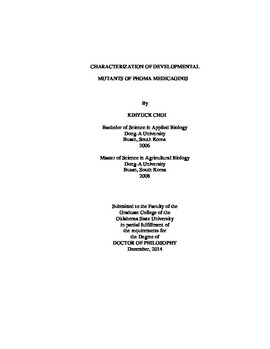| dc.contributor.advisor | Marek, Stephen | |
| dc.contributor.author | Choi, Kihyuck | |
| dc.date.accessioned | 2016-09-29T18:30:01Z | |
| dc.date.available | 2016-09-29T18:30:01Z | |
| dc.date.issued | 2014-12 | |
| dc.identifier.uri | https://hdl.handle.net/11244/45124 | |
| dc.description.abstract | Phoma medicaginis causes spring black stem and leaf spot, an important disease of alfalfa and annual medics. P. medicaginis forms uninucleate conidia in melanized pycnidia and is genetically tractable using Agrobacterium mediated transformation (ATMT), resulting in random integration of T-DNA that occasionally generates pycnidial mutants. One mutant (P265) displays smaller pycnidia and more aerial hyphae than the wild type. A single T-DNA disrupts a putative poly(A) RNA polymerase gene, PmCID13, which in yeasts interacts with ribonucleotide reductase (RNR). As in yeast mutants, P265 shows sensitivity to hydroxyurea (HU), a RNR inhibitor. To functionally characterize PmCID13, targeted Pm(delta)cid13 mutants were created using a hygromycin selectable marker flanked by 1 Kbp regions of PmCID13. Pm(delta)cid13 mutants possess similar morphological features to those of P265. The complementation vector pCAM-NAT (nourseothricin selection) was constructed and used to introduce full-length PmCID13 into mutants. Complemented mutants showed partial recovery of wild type and often lost the original T-DNA due to homologous integration. To our knowledge, this is the first CID13 ortholog to be examined in a filamentous fungus. One T-DNA-tagged mutant produced conidia in non-melanized (hyaline) pycnidia. Pycnidial melanization recovered if the mutant was supplemented with phenoloxidase substrates or allowed to age. DNA sequences flanking the insertion did not predict any disrupted open reading frames (ORF) unless a Coccidioides prediction algorithm was used. The Coccidioides predicted ORF (CPO) was expressed in the wild type, but not the mutant (cpo), and has not been annotated in any genomes, to date. Expression of two conserved genes flanking the T-DNA-disrupted cpo was unchanged from the wild type. Knockout of cpo strain displayed same cultural phenotype (nonmelinized pycnidia). Complementation of cpo strains with wild type CPO partially recovered pycnidial melanization. Both knockout and complementation transformants were confirmed using RT-PCR. CPO appears to be a novel regulator of pycnidium specific melanization. | |
| dc.format | application/pdf | |
| dc.language | en_US | |
| dc.rights | Copyright is held by the author who has granted the Oklahoma State University Library the non-exclusive right to share this material in its institutional repository. Contact Digital Library Services at lib-dls@okstate.edu or 405-744-9161 for the permission policy on the use, reproduction or distribution of this material. | |
| dc.title | Characterization of developmental mutants of Phoma medicaginis | |
| dc.contributor.committeeMember | Garzon, Carla | |
| dc.contributor.committeeMember | Jiang, Haobo | |
| dc.contributor.committeeMember | Mahalingam, Ramamurthy | |
| osu.filename | Choi_okstate_0664D_13761.pdf | |
| osu.accesstype | Open Access | |
| dc.type.genre | Dissertation | |
| dc.type.material | Text | |
| thesis.degree.discipline | Plant Pathology | |
| thesis.degree.grantor | Oklahoma State University | |
